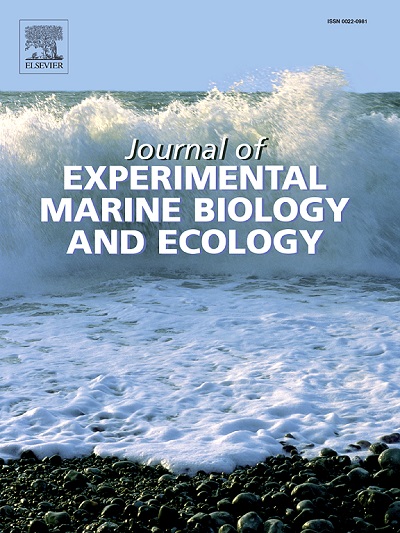Sponge species from New Zealand may transform and degrade dissolved organic matter
IF 1.8
3区 生物学
Q3 ECOLOGY
Journal of Experimental Marine Biology and Ecology
Pub Date : 2025-02-28
DOI:10.1016/j.jembe.2025.152092
引用次数: 0
Abstract
Sponges are an important component of shallow- and deep-water ecosystems enhancing eukaryotic biodiversity via diverse endo- and epibiota and by providing three dimensional habitats for benthic invertebrates and fishes. Sponge biodiversity is particularly high in the waters around New Zealand (Southwest Pacific), where we collected two shallow- and two deep-water sponge species (Tedania sp., Suberea meandrina, Farrea raoulensis, Artemisina sp.) for ex-situ incubation experiments to measure processing of dissolved organic matter (DOM). Several sponge species take up DOM and make it available to other fauna as detritus or as sponge biomass, a process known as sponge loop. However, it is unknown whether the selected sponge species are able to consume dissolved organic carbon (DOC) and/or total dissolved nitrogen (TDN).
We measured DOC and TDN fluxes and linked it to the bacterial communities of the sponge holobiont to address research hypothesis 1. It stated that high-microbial abundance (HMA) sponges consume more DOM than low-microbial abundance (LMA) sponges. Changes in fluorescent dissolved organic matter (FDOM) over time were investigated to address research hypothesis 2. It proposed that the fluorescence intensity Fmax of fluorophores decreased in incubations that showed a significant loss in DOM. We assessed the biochemical and phospholipid-derived fatty acids (PLFAs) composition of sponge tissue to address hypothesis 3. It suggested that the PLFLA composition of sponges differs between sponge classes. Finally, we tried to better understand the role of these sponges in nutrient cycling around New Zealand by combining data from all analyses.
Based on the community composition of the sponge-associated bacteria, we classified Tedania sp., S. meandrina, and Artemisina sp. as HMA sponges and F. raoulensis as LMA sponge. We did not measure a significant DOC flux and only the release of TDN by Tedania sp. was significantly different from 0 μmol TDN g org. C-1 d-1. The presence of four fluorophores were detected in the FDOM pool: 2 tryptophan- and protein-like fluorophores (C1, C2), 1 humic-like fluorophore (C3), and 1 tyrosine-like fluorophore (C4). However, we could not validate hypothesis 2, because Fmax of C1 decreased significantly in S. meandrina incubations, whereas Fmax of C2 grew in the same incubations. Fmax of C3 increased in Tedania sp. incubations, in which Fmax of C4 decreased. In comparison, Fmax of C4 in S. meandrina rose. The PLFA composition of sponge tissue was dominated by long-chain fatty acids, saturated fatty acids, and monosaturated fatty acids, and most PLFAs were sponge- and bacteria-specific. We could not confirmed hypothesis 3, either, because the PLFA composition of the hexactinellid sponge included seven identified PLFAs, whereas the PLFA composition of the demosponges ranged from three to 29 identified PLFAs.
来自新西兰的海绵物种可以转化和降解溶解的有机物
海绵是浅水和深水生态系统的重要组成部分,通过丰富的内、外生物群,以及为底栖无脊椎动物和鱼类提供三维栖息地,增强真核生物的生物多样性。在新西兰(西南太平洋)周围水域,海绵生物多样性特别高,我们在那里收集了两种浅水和两种深水海绵(Tedania sp., Suberea meandrina, Farrea raoulensis, Artemisina sp.)进行离地孵育实验,以测量溶解有机物(DOM)的处理。一些海绵物种吸收DOM,并将其作为碎屑或海绵生物量提供给其他动物群,这一过程被称为海绵循环。然而,目前尚不清楚所选海绵物种是否能够消耗溶解有机碳(DOC)和/或总溶解氮(TDN)。我们测量了DOC和TDN通量,并将其与海绵全息剂的细菌群落联系起来,以解决研究假设1。结果表明,高微生物丰度(HMA)海绵比低微生物丰度(LMA)海绵消耗更多的DOM。研究了荧光溶解有机物(FDOM)随时间的变化,以解决研究假设2。这表明在孵育过程中,荧光团的荧光强度Fmax下降,在DOM中表现出明显的损失。我们评估了海绵组织的生化和磷脂衍生脂肪酸(PLFAs)组成,以解决假设3。说明不同种类海绵的PLFLA组成不同。最后,我们试图通过结合所有分析的数据来更好地了解这些海绵在新西兰周围营养循环中的作用。根据海绵相关菌的群落组成,我们将Tedania sp.、S. meandrina和Artemisina sp.分类为HMA海绵菌,F. raoulensis分类为LMA海绵菌。我们没有测量到显著的DOC通量,只有Tedania sp.释放的TDN与0 μmol TDN有显著差异。颈- 1 d 1。FDOM池中检测到4个荧光团:2个色氨酸和蛋白质样荧光团(C1, C2), 1个腐殖质样荧光团(C3)和1个酪氨酸样荧光团(C4)。然而,我们无法验证假设2,因为C1的Fmax在S. meandrina孵育中显著降低,而C2的Fmax在相同孵育中增加。孵育后C3的Fmax升高,C4的Fmax降低。相比之下,麦冬花中C4的Fmax值较高。海绵组织的PLFA主要由长链脂肪酸、饱和脂肪酸和单饱和脂肪酸组成,并且大多数PLFA具有海绵特异性和细菌特异性。我们也无法证实假设3,因为hexactinellid海绵的PLFA组成包括7个已鉴定的PLFA,而demosponge的PLFA组成范围为3到29个已鉴定的PLFA。
本文章由计算机程序翻译,如有差异,请以英文原文为准。
求助全文
约1分钟内获得全文
求助全文
来源期刊
CiteScore
4.30
自引率
0.00%
发文量
98
审稿时长
14 weeks
期刊介绍:
The Journal of Experimental Marine Biology and Ecology provides a forum for experimental ecological research on marine organisms in relation to their environment. Topic areas include studies that focus on biochemistry, physiology, behavior, genetics, and ecological theory. The main emphasis of the Journal lies in hypothesis driven experimental work, both from the laboratory and the field. Natural experiments or descriptive studies that elucidate fundamental ecological processes are welcome. Submissions should have a broad ecological framework beyond the specific study organism or geographic region.
Short communications that highlight emerging issues and exciting discoveries within five printed pages will receive a rapid turnaround. Papers describing important new analytical, computational, experimental and theoretical techniques and methods are encouraged and will be highlighted as Methodological Advances. We welcome proposals for Review Papers synthesizing a specific field within marine ecology. Finally, the journal aims to publish Special Issues at regular intervals synthesizing a particular field of marine science. All printed papers undergo a peer review process before being accepted and will receive a first decision within three months.

 求助内容:
求助内容: 应助结果提醒方式:
应助结果提醒方式:


